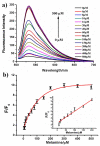Simple and Label-Free Fluorescent Detection of Melamine Based on Melamine⁻Thymine Recognition
- PMID: 30200586
- PMCID: PMC6163348
- DOI: 10.3390/s18092968
Simple and Label-Free Fluorescent Detection of Melamine Based on Melamine⁻Thymine Recognition
Abstract
In the past few years, melamine has been illegally added into dairy products to increase the apparent crude protein levels. If humans or animals drink the milk adulteration of melamine, it can form insoluble melamine⁻cyanurate crystals in their kidneys which causes kidney damage or even death. In the present work, we constructed a simple and label-free fluorescent method for melamine detection based on melamine-thymine recognition. SYBR Green I was utilized as a reporter for this method as it did not require any modification or expensive equipment. In the absence of melamine, polythymine DNA was digested by Exo I, which caused a decrease in the fluorescence signal. In the presence of melamine, the polythymine DNA was able to fold into a double chain structure, however this was done with the help of T-melamine-T mismatches to prevent degradation. Then, the SYBR Green I combined with the double-stranded DNA to result in an intense fluorescence signal. The limit of detection in this method was 1.58 μM, which satisfied the FDA standards. This method also had a good linear relationship within the range of 10⁻200 μM. In addition, this new method has a good selectivity to distinguish melamine from the component of milk. As a result, we developed a simple and highly selectivity method for melamine detection.
Keywords: SYBR Green I; exonuclease I; melamine detection; melamine-thymine recognition.
Conflict of interest statement
The authors declare no conflict of interest.
Figures




Similar articles
-
Exonuclease III-assisted strand displacement reaction-driven cyclic generation of G-quadruplex strategy for homogeneous fluorescent detection of melamine.Talanta. 2019 Oct 1;203:255-260. doi: 10.1016/j.talanta.2019.05.020. Epub 2019 May 18. Talanta. 2019. PMID: 31202335
-
SYBR Green I promotes melamine binding to poly-thymine DNA and FRET-based ratiometric sensing.Analyst. 2021 Mar 7;146(5):1642-1649. doi: 10.1039/d1an00102g. Epub 2021 Feb 17. Analyst. 2021. PMID: 33595033
-
Fluorescence, turn-on detection of melamine based on its dual functions as fluorescence enhancer of DNA-AgNCs and Hg(II)-scavenger.Artif Cells Nanomed Biotechnol. 2019 Dec;47(1):621-625. doi: 10.1080/21691401.2019.1574264. Artif Cells Nanomed Biotechnol. 2019. PMID: 30873874
-
Melamine contamination.Anal Bioanal Chem. 2009 Oct;395(3):729-35. doi: 10.1007/s00216-009-3009-0. Epub 2009 Aug 11. Anal Bioanal Chem. 2009. PMID: 19669733 Review.
-
Analysis of melamine and analogs in complex matrices: Advances and trends.J Sep Sci. 2017 Jan;40(1):170-182. doi: 10.1002/jssc.201600854. Epub 2016 Oct 25. J Sep Sci. 2017. PMID: 27723251 Review.
Cited by
-
Enhancement in Sensitivity and Selectivity of Electrochemical Technique with CuO/g-C3N4 Nanocomposite Combined with Molecularly Imprinted Polymer for Melamine Detection.Polymers (Basel). 2024 Jun 25;16(13):1800. doi: 10.3390/polym16131800. Polymers (Basel). 2024. PMID: 39000656 Free PMC article.
References
MeSH terms
Substances
LinkOut - more resources
Full Text Sources
Other Literature Sources
Medical
Research Materials
Miscellaneous

